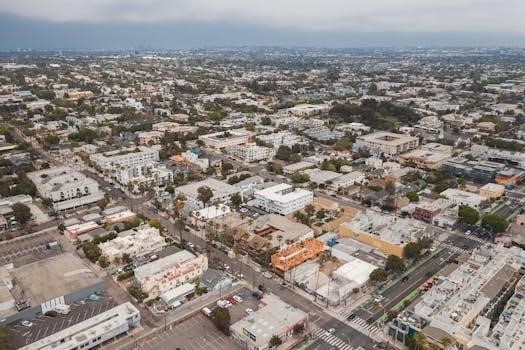Population Growth Worksheet PDF Answer Key⁚ An Overview
Discover resources designed to aid in understanding population dynamics.These worksheets,answer keys, and lesson plans are crafted for educators.They provide tools for exploring population growth factors,calculations,and models.

Understanding Population Growth Factors
Explore elements influencing population size. Birth, death, immigration, and emigration play key roles. Worksheets delve into these factors, aiding in understanding their impact on population trends and dynamics.
Birth and Death Rates
Birth rates and death rates significantly impact population size. A high birth rate relative to the death rate leads to population increase, while the opposite results in decline. These rates are influenced by factors like healthcare, sanitation, nutrition, and socioeconomic conditions. Understanding these influences is crucial for analyzing population growth trends. Worksheets often include exercises that involve analyzing birth and death rate data to determine population growth or decline. These exercises may require calculating crude birth rates (number of births per 1,000 people) and crude death rates (number of deaths per 1,000 people). Additionally, students might explore age-specific birth and death rates to gain a more nuanced understanding of population dynamics. The availability of resources, access to family planning, and cultural norms also play a significant role in shaping birth and death rates. Analyzing these factors in conjunction with statistical data provides a comprehensive view of how birth and death rates drive population changes. Moreover, the impact of events such as epidemics, famines, and wars on death rates can be examined through historical data analysis included in worksheets.
Immigration and Emigration
Immigration and emigration are key factors influencing population change alongside birth and death rates. Immigration refers to the movement of individuals into a population from another area, increasing the population size. Emigration, conversely, is the movement of individuals out of a population to another area, decreasing the population size. Net migration, the difference between immigration and emigration, significantly contributes to population growth or decline in a specific region or country. Worksheets often include scenarios and data sets that require students to calculate net migration rates and analyze their impact on overall population growth. These exercises may involve considering push and pull factors that influence migration patterns. Push factors are conditions that drive people to leave an area, such as economic hardship, political instability, or environmental disasters. Pull factors are conditions that attract people to a new area, such as job opportunities, better living conditions, or political freedom. Understanding these factors is essential for interpreting migration trends and their effects on population dynamics. Furthermore, the impact of immigration and emigration on age structure, cultural diversity, and economic development can be explored through worksheet activities.Analyzing real-world case studies provides a deeper understanding of the complex interplay between migration and population change.
Calculating Population Growth
Population growth calculation involves formulas to determine how populations change over time.Worksheets assist students in applying these formulas, analyzing birth and death rates, and immigration/emigration data.
The Formula for Population Growth
The basic formula for population growth considers births, deaths, immigration, and emigration. It’s often expressed as⁚ Population Growth = (Births + Immigration) ─ (Deaths + Emigration). Worksheets often require students to use this formula to calculate population changes given specific data sets. Some worksheets might also introduce more complex models that account for factors like age structure or carrying capacity. Understanding this formula is crucial for predicting future population sizes and the resources needed to sustain them.
Answer keys provide the correct solutions, allowing students to check their work and reinforce their understanding. Additionally, teachers can use these worksheets to assess students’ ability to apply mathematical concepts to real-world ecological scenarios. Furthermore, some resources include practice problems where students must calculate growth rates and doubling times, enhancing their analytical skills. Exponential and logistic growth models, concepts often explored in these worksheets, build upon this basic formula. They introduce elements like carrying capacity, leading to a more nuanced understanding of population dynamics.
Essentially, mastering the population growth formula equips students with a foundational tool for analyzing and predicting changes in population sizes, and the associated worksheets offer comprehensive practice.
Population Histograms and Their Interpretation
Population histograms, also known as age-sex pyramids, are graphical representations that display the distribution of a population by age and gender. These histograms provide valuable insights into the demographic structure of a population, revealing trends in birth rates, death rates, and overall population growth. Analyzing the shape of a population histogram allows us to infer whether a population is growing rapidly, slowly, or declining. For instance, a pyramid with a wide base and a narrow top indicates a rapidly growing population with a high proportion of young individuals. Conversely, a pyramid with a narrow base and a wider top suggests a declining population with a larger proportion of older individuals.
Worksheets related to population histograms often involve interpreting these graphs to draw conclusions about population trends. Students might be asked to identify the age groups that are most prevalent in a population, compare histograms from different countries or time periods, or predict future population growth based on the shape of the histogram. Answer keys provide the correct interpretations, helping students develop their analytical skills and understanding of demographic data. These resources enhance students’ ability to understand the relationship between population structure and future population trends.
Overall, population histograms are essential tools for understanding population dynamics, and these worksheets and answer keys provide valuable practice in interpreting these graphs, enabling students to draw meaningful conclusions about population growth and demographic trends based on visual data.

Exponential vs. Logistic Growth Models
Exponential and logistic growth models are two fundamental concepts in population ecology that describe how populations increase over time. Exponential growth occurs when a population has unlimited resources and can grow at its maximum potential rate. This type of growth is characterized by a J-shaped curve, where the population size increases rapidly and continuously. However, exponential growth is unsustainable in the long term because resources are finite and environmental conditions are not always ideal.
In contrast, logistic growth takes into account the limitations of resources and the carrying capacity of the environment. Carrying capacity is the maximum population size that an environment can sustain given the available resources. As a population approaches its carrying capacity, its growth rate slows down due to factors such as competition for resources, increased predation, and disease. Logistic growth is characterized by an S-shaped curve, where the population initially grows exponentially but then gradually slows down as it approaches the carrying capacity.
Worksheets on exponential and logistic growth models often involve calculating population growth rates, graphing population sizes over time, and analyzing the factors that influence population growth. Answer keys provide the correct solutions and explanations, helping students understand the differences between these two models and their implications for population dynamics. These resources may include real-world examples, such as the growth of bacteria in a petri dish or the recovery of a salmon population after a dam removal, to illustrate the concepts and enhance student engagement. By studying these models, students can develop a deeper understanding of how populations grow and interact with their environment.

Human Population Growth Trends
Human population growth trends are a critical area of study, reflecting the dynamic interplay of birth rates, death rates, migration, and various socioeconomic factors. Over the course of history, the human population has experienced periods of slow growth followed by periods of rapid expansion, particularly since the advent of the Industrial Revolution. This growth has been fueled by advancements in medicine, agriculture, and sanitation, which have led to decreased mortality rates and increased life expectancy.
Currently, the global human population is growing at a rate that, while slowing, still adds a significant number of people to the planet each year. However, population growth rates vary considerably across different regions and countries. Some regions, such as sub-Saharan Africa, are experiencing high population growth rates, while others, such as Europe and Japan, are facing declining populations. These variations are influenced by factors such as cultural norms, access to education and healthcare, economic opportunities, and government policies.
Understanding human population growth trends is essential for addressing a range of global challenges, including resource scarcity, environmental degradation, and social inequality. Worksheets and answer keys related to this topic often involve analyzing demographic data, interpreting population pyramids, and evaluating the impact of population growth on the environment and society; Students may be asked to calculate growth rates, predict future population sizes, and propose solutions to mitigate the negative consequences of overpopulation or population decline. By studying these trends, students can gain a deeper appreciation for the complexities of human population dynamics and the challenges and opportunities they present.

Resources for Population Growth Studies
Explore available resources for studying population growth.This includes worksheets,answer keys,and lesson plans tailored for various educational levels.They offer a structured approach to understanding population dynamics.
Worksheets, Answer Keys, and Lesson Plans
Access a variety of educational materials designed to facilitate the study of population growth. Worksheets provide structured activities for students to practice calculating growth rates, interpreting population histograms, and analyzing factors that influence population size. These resources often include real-world scenarios and data sets to enhance understanding and application of concepts.
Answer keys are essential tools for educators, offering correct solutions to worksheet questions and exercises. They enable teachers to efficiently assess student comprehension and provide targeted feedback. Moreover, answer keys can serve as valuable resources for self-assessment, allowing students to check their work and identify areas where they need further clarification;
Lesson plans offer a comprehensive framework for teaching population growth concepts. They typically include learning objectives, background information, activity suggestions, and assessment strategies. Lesson plans can be tailored to different grade levels and learning styles, ensuring that all students have the opportunity to engage with the material in a meaningful way. Many lesson plans incorporate interactive activities, such as simulations and group discussions, to promote active learning and critical thinking.
These resources collectively provide a robust foundation for exploring population growth, equipping students with the knowledge and skills necessary to analyze population trends, understand the factors driving population change, and make informed decisions about environmental issues.
